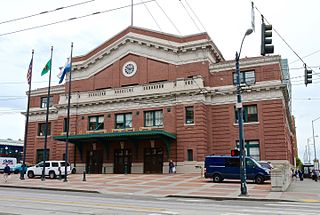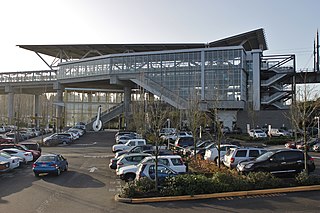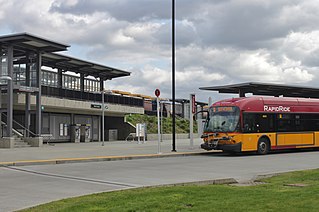
Sound Transit (ST), officially the Central Puget Sound Regional Transit Authority, is a public transit agency serving the Seattle metropolitan area in the U.S. state of Washington. It operates the Link light rail system in Seattle and Tacoma, regional Sounder commuter rail, and Sound Transit Express bus service. The agency also coordinates the regional ORCA fare card system, which is also used by local transit operators. In 2019, Sound Transit services carried a total of 48 million passengers and averaged over 161,000 riders on weekdays.

Community Transit (CT) is the public transit authority of Snohomish County, Washington, United States, excluding the city of Everett, in the Seattle metropolitan area. It operates local bus, paratransit and vanpool service within Snohomish County, as well as commuter buses to Downtown Seattle and Northgate station. CT is publicly funded, financed through sales taxes, and farebox revenue, with an operating budget of $133.2 million. In 2022, the system had a ridership of 5,788,700, or about 24,300 per weekday as of the third quarter of 2023, placing it fourth among transit agencies in the Puget Sound region. The city of Everett, which serves as the county seat, is served by Everett Transit, a municipal transit system.

The Ballard Terminal Railroad Company LLC operates two Class III short line terminal railroads in western Washington, United States. Founded in 1997 to operate a three-mile spur through Seattle's Ballard neighborhood, the Ballard Terminal Railroad has expanded to operate two additional lines in the Puget Sound area, including Eastside Freight Railroad from Snohomish to Woodinville, Washington, and Meeker Southern Railroad, a 5 mi (8.0 km) segment from East Puyallup ("Meeker") to McMillin, Washington. Eastside Freight Railroad has ceased operation as of mid 2020.
FasTracks is a multibillion-dollar public transportation expansion plan under construction in metropolitan Denver, Colorado, United States. Developed by the Regional Transportation District (RTD), the plan consists of new commuter rail, light rail, and express bus services. Six new light rail, electric commuter rail and diesel commuter rail lines with a combined length of 122 miles (196 km) will be constructed under the plan. It expands on previous transportation projects, notably T-REX, and includes 57 new transit stations and stops, 21,000 new parking spaces, 18 miles (29 km) of a bus service between Denver and Boulder and the renovation of Denver Union Station as a multi-modal transportation hub.

Everett Station is an Amtrak train station serving the city of Everett, Washington, United States. The station has provided service to the Cascades and Empire Builder routes since its opening in 2002, replacing an earlier station near the Port of Everett. The four-story building also houses social service programs and is the center of a 10-acre (4 ha) complex that includes parking lots and a large bus station used primarily by Community Transit, Everett Transit, and Sound Transit Express. The station has served as the northern terminus of the Sounder N Line since 2003 and the Swift Blue Line since 2009. It consists of two side platforms, one serving Amtrak and the other serving Sounder commuter trains. Everett Station also functions as a park and ride, with 1,067 short-term parking spaces located in lots around the station after it was expanded by Sound Transit in 2009.

Mukilteo station is a train station serving the city of Mukilteo, Washington. It is owned by Sound Transit, who runs the N Line of the Sounder commuter rail service through the station from Everett to King Street Station in Seattle. The station includes a parking lot with 63 spaces, as well as connections to nearby Washington State Ferries, Community Transit, and Everett Transit service on State Route 525. Mukilteo station opened in 2008 with a single side platform, later supplemented with a second platform and pedestrian overpass in 2016.
The Woodinville Subdivision is a railroad line that was formerly owned by BNSF Railway. It takes its name from one of its original end points in Woodinville, Washington, United States. The line extends approximately 42 miles (68 km) in east King County and Snohomish County. The line's ownership has been transferred in a deal involving King County and the Port of Seattle. The section from Snohomish to Woodinville was operated, on contract, by a company called Eastside Rail Freight, which is associated with the Ballard Terminal Railroad and Meeker Southern. However, train traffic on the subdivision is exceedingly rare, with the Seattle region's rail operations now conducted on other higher capacity routes.
The Bottineau LRT is a proposed light rail line extension in the Minneapolis – Saint Paul Metro area, projected to run northwest from Target Field station in downtown Minneapolis along County Road 81 to Brooklyn Park.

The ORCA card is a contactless, stored-value smart card system for public transit in the Puget Sound region of Washington, United States. The card is valid on most transit systems in the Seattle metropolitan area, including Sound Transit, local bus agencies, Washington State Ferries, the King County Water Taxi, and Kitsap Fast Ferries. It was launched in 2009 and is managed by the Central Puget Sound Regional Fare Coordination Project, a board composed of local transit agencies.
Roads and Transit was a ballot measure in the U.S. State of Washington concerning transportation, that was sent to voters in the Snohomish, King, and Pierce Counties for approval on November 6, 2007. It was defeated by a margin of 56% to 44%.

Tukwila International Boulevard station is a light rail station in Tukwila, Washington, United States. It is located between SeaTac/Airport and Rainier Beach stations on the 1 Line from Seattle–Tacoma International Airport to Downtown Seattle. The station consists of two elevated side platforms enclosed within a structure northeast of the interchange of State Route 99 and State Route 518. As one of three park and rides along the line, it includes 600 parking spaces in two lots.

SODO station is a light rail station located in Seattle, Washington. It is situated between the Beacon Hill and Stadium stations on the 1 Line, which runs from Seattle–Tacoma International Airport to Downtown Seattle and the University of Washington as part of the Link light rail system. The station consists of two at-grade side platforms at the intersection of the SODO Busway and South Lander Street in the SoDo neighborhood of Seattle.

Tukwila station is a train station in Tukwila, Washington, United States. The station was built by Sound Transit to serve its Sounder commuter rail service on the S Line, as well as Amtrak's intercity Cascades line. It includes 390 parking spaces and a bus platform served by King County Metro's RapidRide F Line and other routes.

Auburn station is a train station in the city of Auburn, Washington, United States, served by S Line of the Sounder commuter rail network. It is located southwest of downtown Auburn and consists of two train platforms, a bus station, a parking garage, a public plaza, and a pedestrian bridge. The station has 633 parking spaces and is also served by Sound Transit Express, King County Metro, and Pierce Transit buses. Auburn station opened in 2000 and was built on the site of a former railroad station that was demolished in 1979. The parking garage and pedestrian bridge opened in 2003, and a second parking garage is planned to be built by 2027.

The Puget Sound region is a coastal area of the Pacific Northwest in the U.S. state of Washington, including Puget Sound, the Puget Sound lowlands, and the surrounding region roughly west of the Cascade Range and east of the Olympic Mountains. It is characterized by a complex array of saltwater bays, islands, and peninsulas carved out by prehistoric glaciers.
The Central Maryland Transportation Alliance (CMTA) is a coalition of Baltimore area business, civic and nonprofit groups intent on improving travel within Central Maryland, which consists of Baltimore City and the surrounding jurisdictions of Anne Arundel County, Baltimore County, Carroll County, Harford County and Howard County. The group's stated objectives are to reduce congestion, limit sprawl, increase job opportunities and make it easier, faster and more efficient for anyone to travel within Central Maryland.

The Eastside Rail Corridor, officially Eastrail, is a rail right of way where a rail trail has been under development in the Eastside suburbs of Seattle, Washington. The corridor follows the path of the former Woodinville Subdivision from Renton to the City of Snohomish at Snohomish Junction. As of 2017, the northern portion was still in operation by Eastside Freight Railroad.

The Northwest Seaport Alliance is a port authority based in the Puget Sound region of the United States, comprising the seaports of Seattle and Tacoma in Washington state. The combined port authority is the third largest cargo port in the United States and by container volume.

The Point Defiance Bypass is a 14.5-mile-long (23.3 km) rail line between the cities of DuPont and Tacoma in Pierce County, Washington. It was originally built by the Northern Pacific Railway – the Tacoma–Lakewood segment in 1874 as part of the Prairie Line, and the Lakewood–DuPont section in 1891. Passenger service on the lines declined after the 1914 completion of a flatter route along Puget Sound, and ended entirely in 1956.
Esterra Park is a transit-oriented development under construction in the Overlake area of Redmond, Washington. The 28-acre (11 ha), 3.0 million square feet (280,000 m2) project is near major regional shopping and employment centers and multiple modes of transportation, including the future Overlake Village light rail station scheduled to open in 2023. The Esterra Park campus is expected to be home to a combined 8,000 residents and workers.














